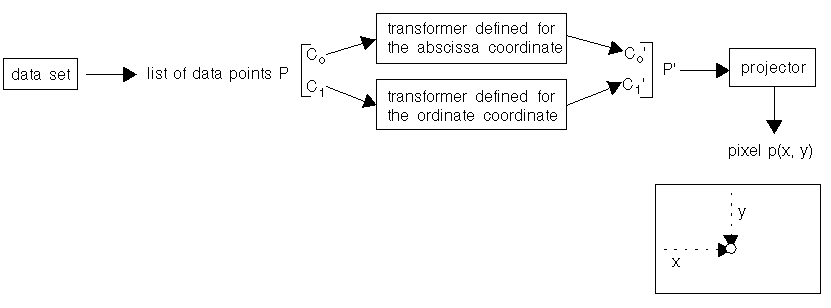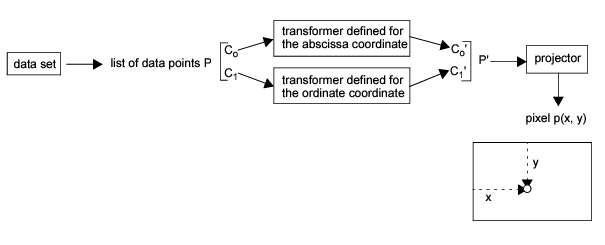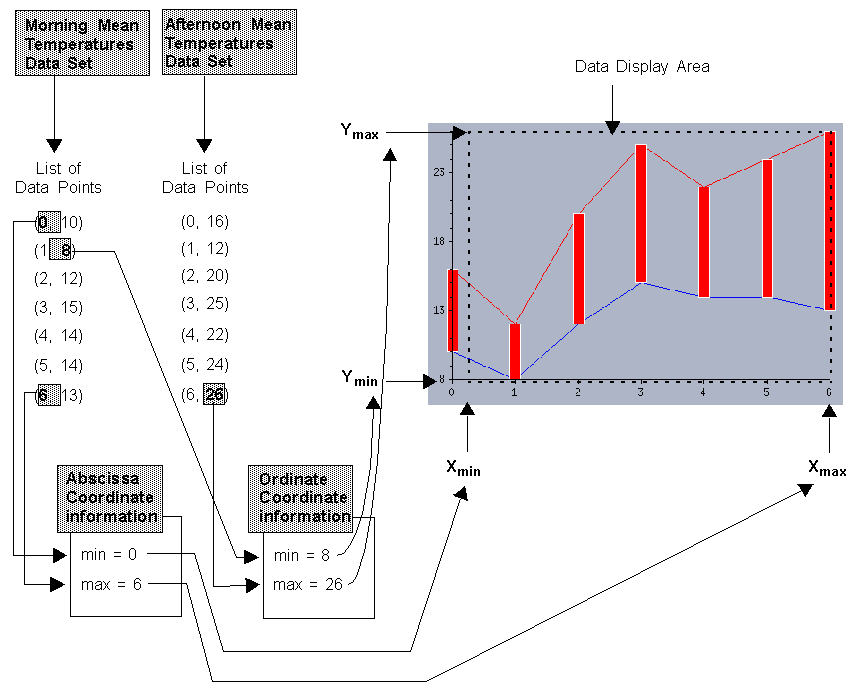How Displayer Objects Draw the Graphical Display
The drawing of the graphical representations of data is performed by the displayer objects. In order to draw a graphical representation of the data, a displayer needs to have the data points of the data set(s) it is going to display expressed in screen coordinates.
Transforming Data Points into Screen Coordinates
Transforming Data Points into Screen Coordinates illustrates how the data points represented by a given data set are transformed into screen coordinates.
1. From a given data set, we get the data points in the form P(C0, C1) that are represented by the data set. C0 is the abscissa value and C1 the ordinate value of the data point.
2. Each data point P is transformed into P' by applying the transformer defined for the abscissa coordinate to its abscissa value C0 and the transformer defined for the ordinate coordinate to its ordinate value C1. These transformers are stored in the coordinate information objects associated with the abscissa and the ordinate scales considered by the displayer to display the data set. The same abscissa coordinate information object is used by all the displayers since the chart uses only one abscissa scale. The ordinate coordinate information object that must be used by a given displayer is stored in this displayer (in the form of a pointer).
3. The transformed point P' is passed to the projector that finally projects the point into the point p(x, y) expressed in screen coordinates. (For details about this step, see Projecting Transformed Data Points into Screen Coordinates.)


Transforming Data Points into Screen Coordinates
Projecting Transformed Data Points into Screen Coordinates
To project the transformed data points into screen coordinates (see step 3 on page 127), the projector needs the following information:
Using this information, the projector then maps the transformed data points into screen coordinates so that the data points occupy the largest amount of space within the data display area.
Mapping the Temperatures Data into Screen Coordinates illustrates these concepts. (Once again, we are using our Temperatures Chart as an example.) Our chart uses one abscissa scale and one ordinate scale. Therefore, all of the displayers consider the same ordinate scale when displaying the data. By default, the minimum and maximum data values that are considered for the abscissa and ordinate scales of the chart are automatically computed so that all the data points can be displayed. For the abscissa scale, these values correspond to the minimum and maximum abscissa values in the lists of data points of the morning and afternoon mean temperatures data sets. For the ordinate scale, these values correspond to the minimum and maximum ordinate values in the lists of data points of the morning and afternoon mean temperatures data sets.


Mapping the Temperatures Data into Screen Coordinates
Published date: 05/24/2022
Last modified date: 02/24/2022





